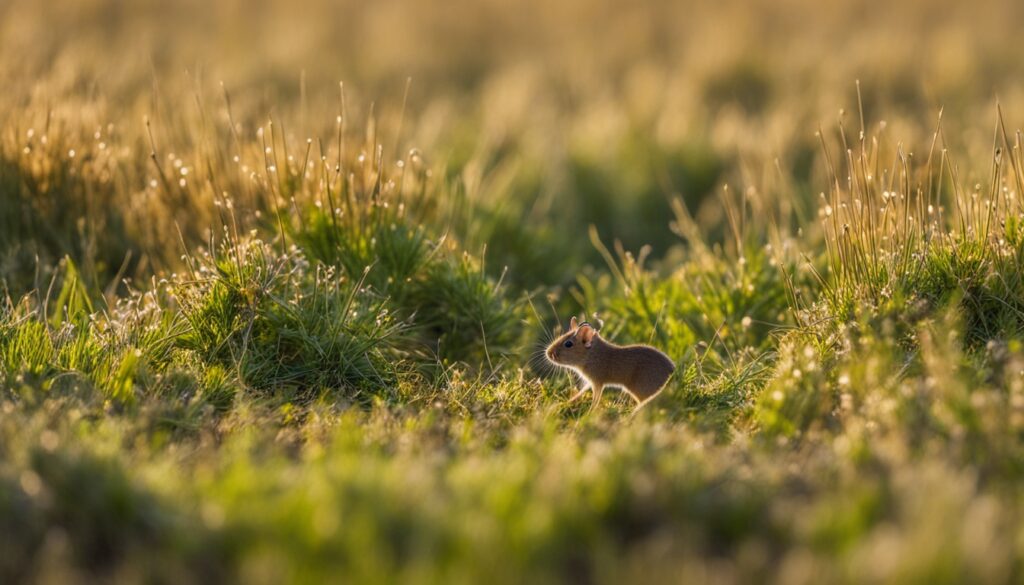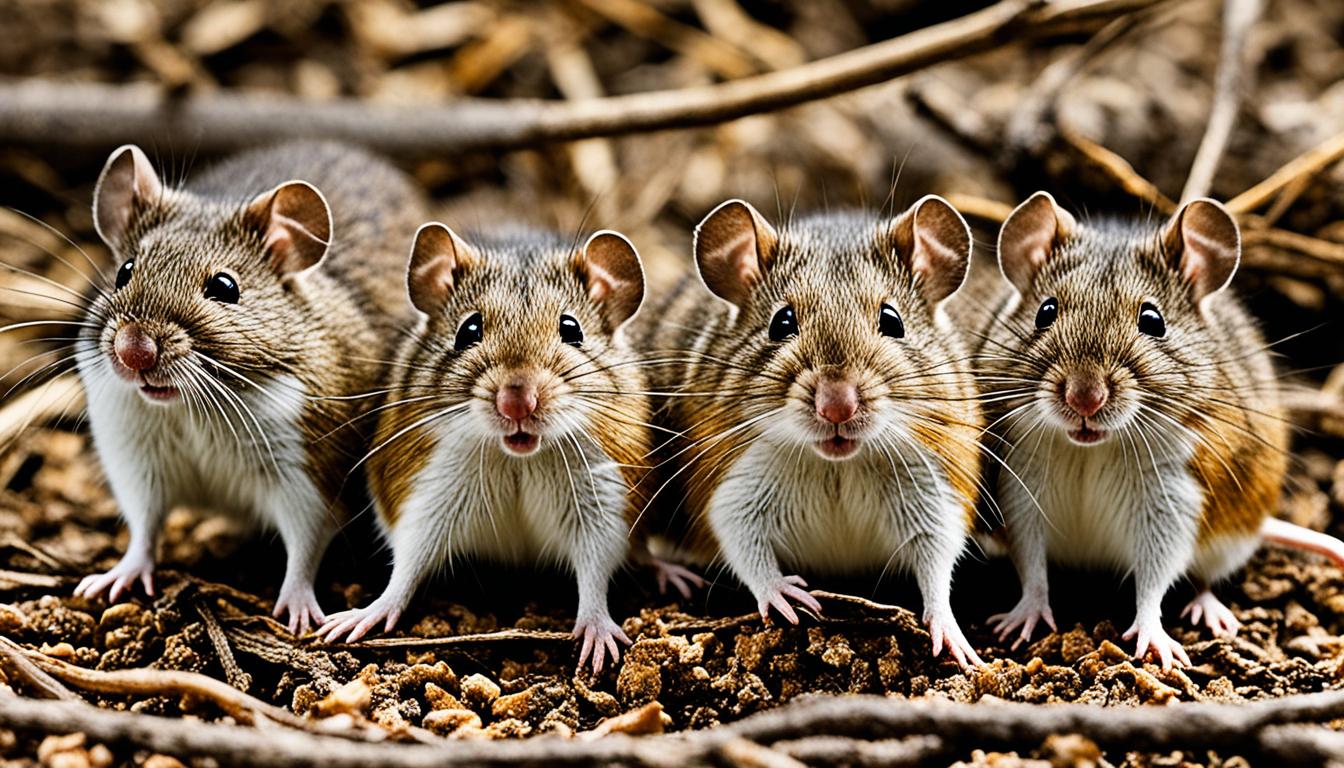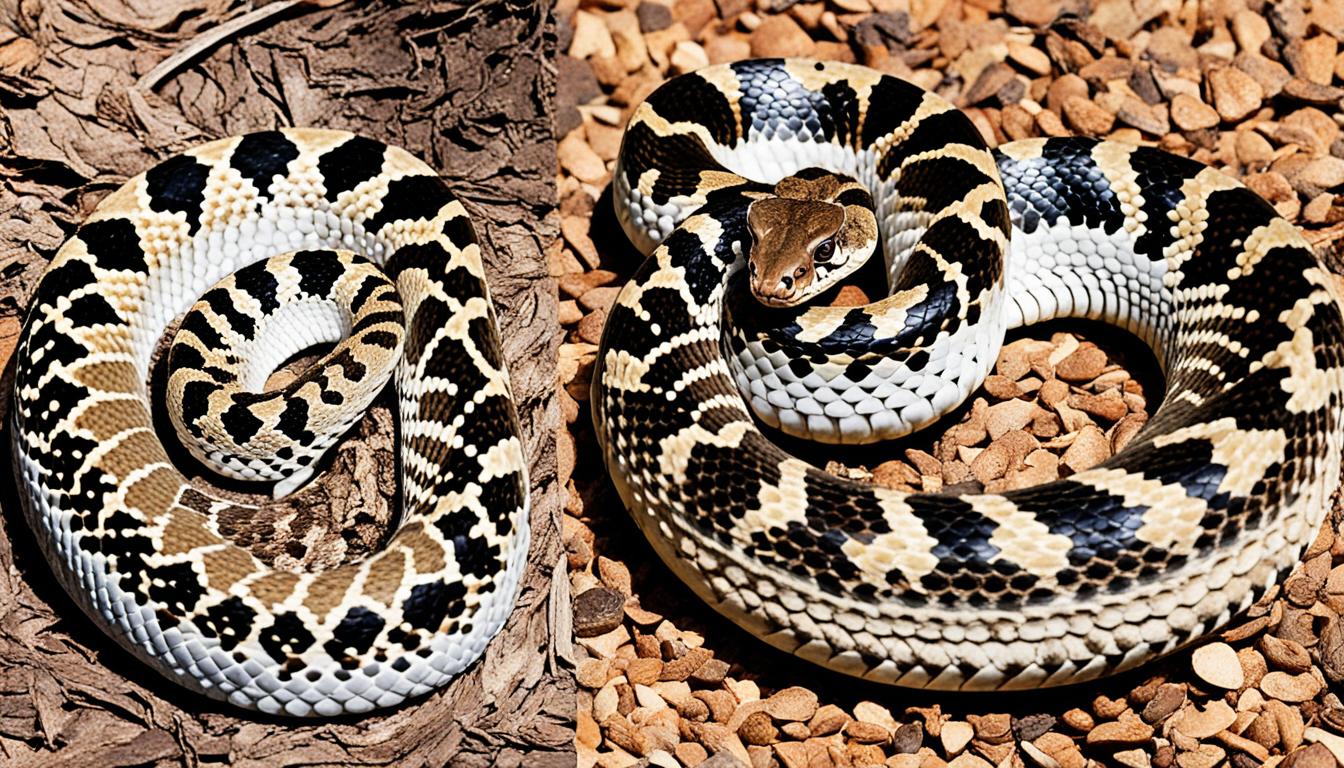Rodents are a big group of mammals found almost everywhere, except New Zealand and Antarctica. They have sharp teeth, long tails, and move quickly. Rodents weigh less than 7 pounds and come in many types, like mice, rats, beavers, squirrels, and chipmunks. They often bother homeowners, looking for warmth in the winter.
Mice are common in American homes. This includes house, field, and wood mice. They bring health risks and damage your property. Rats, such as Norway and black rats, are also found near people. Smaller rodents like chipmunks and squirrels can invade your space too, each with their own tricks.
Knowing about these rodent types and how they act helps you keep your home and health safe.
Introduction to Rodents
Rodents are part of the order Rodentia. This group is known for various species with unique characteristics. They are recognized by their teeth that keep growing. This makes them a concern for the damage they cause while gnawing.
Characteristics of Rodents
Rodent characteristics include sharp, always growing incisors. These are key for gnawing and worn against hard objects. Rodents don’t have canine teeth and have a gap behind their incisors. Their agility stands out due to their four nimble limbs, allowing them to climb and burrow well.
Habitats of Rodents
Rodent habitats span from fields and forests to cities. Their choice often depends on available food, such as seeds and fruits. Mice and rats prefer living near humans. Beavers and squirrels, on the other hand, like natural spots. Knowing about these habitats helps with rodent identification and control.
| Rodent | Habitat | Characteristics | Identification Tips |
|---|---|---|---|
| Mice | Urban and rural areas | Small size, sharp incisors, nocturnal | Look for droppings and gnawed materials |
| Squirrels | Woodlands, parks | Long bushy tail, excellent climbers | Observe their nesting in trees and attics |
| Beavers | Forested areas near water | Large size, webbed feet, strong incisors | Identify by their dams and lodges |
| Rats | Urban areas, sewers | Robust body, sharp incisors, nocturnal | Spot signs like droppings and gnaw marks |
House Mice
House mice are skilled at making their way into our living spaces. They often choose hidden spots to live. They can climb and jump well. This helps them stay close to where they find food.
Behavior and Habitat
House mice look for places rich in both food and safety. Look for them in your attic, basement, and wall spaces. They can use their climbing skills to get almost anywhere. You might only see signs of their activity at night.
Health Threats and Damages
Despite their small size, these mice are a big health risk. They can pass on diseases like Salmonella. This happens through food and surfaces they touch. Their droppings are also dangerous. They can cause allergies and asthma. Plus, they can chew up your home. Insulation, wiring, and stored items are all at risk.
Prevention Tips
To keep your home safe, start with good rodent prevention methods. Keep your storage areas clean and food sealed up. Don’t forget to clear away any clutter. This makes your home less inviting to mice. Make sure to seal up any possible ways they can get in. And, always keep your space clean.
| Rodent Infestation Signs | Preventive Measures |
|---|---|
| Droppings | Seal food containers |
| Gnaw marks | Reduce clutter |
| Scratching noises | Seal entry points |
Norway Rats
Norway rats, also called brown rats, love being near humans at night. They build homes close to where they can find food. This makes them a big issue in cities.
Behavior and Habitat
These rats live in many places like sewers and basements. They are active at night. They look for food, water, and a place to sleep.
They make tunnels underground. This can harm buildings and outside areas.
Health Threats and Damages
Norway rats are not just a problem. They can spread diseases to people. They might cause illnesses like jaundice and rat-bite fever.
They also damage property by chewing. This can cause fires and water leaks.
Prevention Tips
To tackle Norway rats, you need to act smart. Look out for signs of rats. These can be droppings, chew marks, or oily stains on walls.
Keep your place very clean. This makes it hard for rats to find food. Also, fix any holes or weak spots they might use to get in. Staying alert and fixing issues fast can keep you safe from rat problems.
| Preventive Measure | Description |
|---|---|
| Regular Inspections | Conduct frequent checks for droppings, gnaw marks, and signs of burrowing. |
| Improve Sanitation | Keep areas clean and free of food debris to reduce attractants. |
| Secure Entry Points | Seal existing gaps and cracks in the foundation and walls to prevent entry. |
| Eliminate Nesting Materials | Remove clutter and vegetation that could be used for nesting. |
Roof Rats
Roof rats are good climbers, so they like to live high up in places like trees and buildings. This keeps them safe from many animals that might want to catch them. It also means they’re closer to food, like overripe fruits and trash. To deal with roof rats, it’s important to know about where they live and why.
Behavior and Habitat
Roof rats make their homes in high spots like attics and rafters. They’re really active at night, using power lines and tree limbs to get around. They eat just about anything, from fruits and nuts to scraps and pet food.
Health Threats and Damages
Centuries ago, roof rats were linked to spreading the plague. Even today, they can carry serious diseases like typhus and trichinosis. So, if you find roof rats in your area, it’s important to get rid of them fast. They can also chew through things in your home, which leads to expensive fixes.
Prevention Tips
Preventing a roof rat infestation is best done by removing what attracts them to your place. This means getting rid of fallen fruits and making sure your trash cans are tightly closed. You should check for signs of them, like droppings, from time to time. Here’s a list of steps to help keep roof rats away:
- Remove fallen fruits promptly from your yard.
- Ensure garbage receptacles are properly sealed.
- Trim tree branches that touch or hang over your house.
- Seal any gaps or openings in your home’s exterior to prevent entry.
Acting fast and keeping an eye out can help stop these pests from settling in.
| Preventive Measure | Description |
|---|---|
| Remove Food Sources | Clear fallen fruits and secure garbage containers. |
| Trim Tree Branches | Maintain a gap between tree branches and your home. |
| Seal Entry Points | Close any small gaps or holes in the building’s exterior. |
| Regular Inspections | Check for droppings, nests, and gnaw marks frequently. |
Deer Mice
Deer mice live in wild areas and might come near homes, looking for warmth in winter. It’s important to know about them to stay safe. This includes where they live, the risks they bring, and how to keep them away.
Behavior and Habitat
Deer mice like to hide and make nests where they can find food. They mainly live in country places and forests. They are good at hiding, making it hard to get rid of them.
Health Threats and Damages
Deer mice can spread a virus called hantavirus. This can make people very sick by getting into the air from mouse droppings or urine. They can also damage food and things in your home.
Prevention Tips
Stopping deer mice from coming in is key for your health and home. Keep food safe and remove places where they can hide. Always keep your home clean. This helps keep you and your family safe from them.
Field Mice
Field mice are different from house mice as they prefer open fields. They can be a problem when they enter homes in the cold.

These rodents are quick and small, which makes them hard to spot at first. They look for warm spots inside, like garages and basements, where they can find food. This behavior causes issues with field mice.
Finding these unwelcome guests early is key to keeping them under control. Look for signs they’ve been around, like droppings and gnaw marks. Getting help from professionals to get rid of them quickly is important before their numbers grow.
Field mice can chew on important things like wires and insulation. They might also carry diseases. To keep your home safe, clean up messes and block how they get in.
- Inspect your home periodically for signs of field mice.
- Ensure food sources are securely stored.
- Seal any cracks or openings in your home’s exterior to prevent entry.
Wood Mice
Wood mice love areas that are like forests and woods. They usually don’t live in cities. But, when they move into houses, they can cause problems.
It’s key to know where wood mice like to live. They choose places with lots of hiding spots and food. So, they often end up in gardens, attics, and basements near forests.
To stop mice from getting in, seal up any holes on the outside of your house. This means checking doors, windows, and the base of your house. Also, keep your house clean and neat. Put food in seal-tight containers. Make sure to throw out the trash regularly.
By doing these things, you can avoid issues with wood mice. This will make your home feel safer and more welcoming.
Chipmunks
Chipmunks are small but can cause big problems in places like homes and gardens. These quick little animals love to dig and can make homes under the ground or around your yard. This could lead to trouble for you.
Behavior and Habitat
Found mainly in the woods, chipmunks are also seen in cities and suburban areas. They are always looking for food, which brings them into your home, yard, or garden. Chipmunks dig complex tunnels that can hurt the ground and even your home over time.
Risks to Property
A chipmunk’s burrowing can hurt your home’s base, walls, or sidewalks. They also mess up gardens by digging up plants. Inside, they might chew on wires or insulation, which is dangerous and can weaken your home. Dealing with this damage can be expensive and hard.
Prevention Tips
To keep chipmunks away and your house safe, take steps to stop them from getting in. Block any holes or openings on the outside. Using mesh fences can also protect gardens. Make sure not to leave out food like birdseed or fruits that they love. This way, you can avoid the problems they cause.










